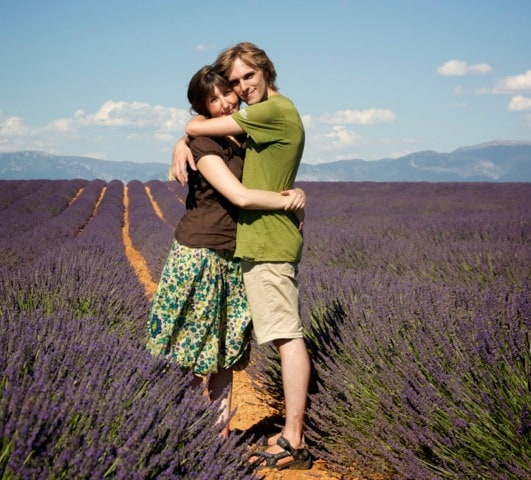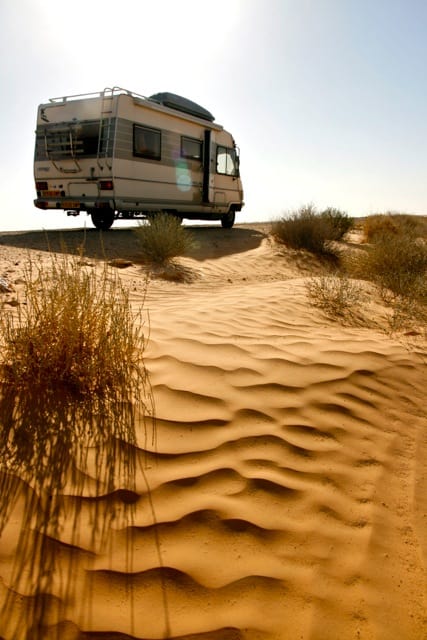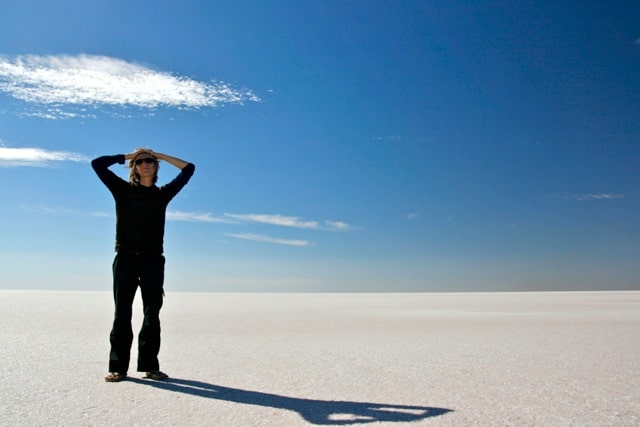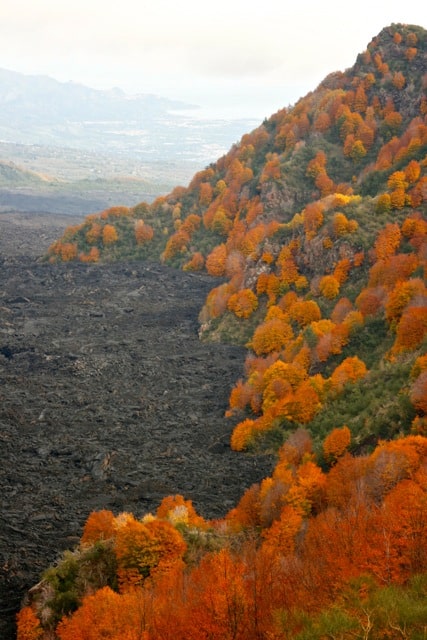This page contains affiliate links. Please read our disclosure for more info.
Michael and Katherine of Technomadics are seriously impressive. They’ve been living out of a motorhome in Europe for the past three years while creating beautiful and useful iPhone/iPad apps that have become so successful they’ll be able to buy a house outright when they eventually return to Australia. They are such an inspiration to us as we work on our first major app.
1) How long have you been travelling and where have you been?
We’ve just recently celebrated our third year on the road! Here’s our story so far.
In short (well – relatively short): We started in the UK – where we found our motorhome, Nettle – spent a month learning the ropes in Ireland, then made a beeline to Italy for a few months. We spent 3 somewhat gruelling but highly educational months in Tunisia, then headed back northward through Italy for 3 months. Then, straight back to the UK for a year, where we spent several months in Cornwall, and house-sat in a farm cottage in Wales over winter, ending up in Scotland. Then, back across to Belgium, into France, with an unexpected and hasty jaunt up to Copenhagen for bureaucracy’s sake, then 6 months in the south of France, mostly in the Pyrenees. A brief visit to Barcelona, then a month or so in Provence, and now we’re back in the UK for 6 months, before we go back to Europe again.
2) What made you decide to become digital nomads?
Well, it wasn’t so much of a decision as much as something we fell into naturally, almost. We both wanted to see the world for a long time. First it was a vague ambition, but then we started talking about it in earnest. Then, Katherine had the idea of motorhoming – the perfect option for two homebodies like us: it’s the having cake/eating cake of travel, taking our home with us while we see the world.
At the same time, I’d just built my first iPhone app (while I probably should’ve been working on my PhD. Don’t tell my supervisor…), and realised that was what I really wanted to do.
Honestly, it all just…fell into place, almost on its own. Then it was just a matter of following steps to make it happen – with a bit of good fortune along the way.
3) How do you fund your travels?
At the beginning, we were pretty much just living off our savings, which we’d scraped together while obsessively house-sitting every chance we got back in Melbourne – that was helped along significantly by some wonderful family members who let us look after their homes while they went and did some travel of their own. My first app helped us along a fair bit, but in the early days, it was really a token gesture.
Actually, something we discovered quite quickly, to our surprise, was the inexpensiveness of this lifestyle once we’d made the initial investment of a motorhome. We were paying $40 AUD a day in rent alone back in Melbourne, when we were renting. While travelling in Italy, allegedly one of the more expensive European countries to travel in, we were topping out at $40 – for everything: fuel, food, internet, you name it. When we actually slow down, it’s even cheaper. So, we didn’t feel a great deal of financial pressure.
While we were meandering our way up through Italy, I started working on a new app, which began as a personal project for our own use – something to let us plan our various outings throughout the country on a map, dropping placemarks on stuff we wanted to see. I realised it’d make more sense to aim higher, and actually make a product. It took nine months, but I shipped The Cartographer while we were living in Wales, with a bunch of PR assistance from Katherine. Things started slow, and we held off our disappointment until one morning we got up to discover we’d been featured by Apple. For nine weeks straight!
Those initial amazing sales settled down gradually, ending up below the level necessary to avoid dipping into our savings still, but it was a start, and that nine months really whet my appetite for software development and design. I ploughed on into my next project: Reinventing my first app, Loopy. That took another seven months of work, and then things really took off. Loopy is a live-looper app, which is a musical tool that lets you record and layer looped samples to build up music – it’s something that is incredible to watch, live. A well-known live looper, Dub Fx, basically took us under his wing after I reached out to him, and blew all expectations out of the water when he released a video demonstrating the app. The response was near miraculous, giving the app just the kick it needed.
Things have progressed from there, with the release of an iPad version, and I’m thrilled to say we’re at the point where we are planning on buying a house (sans-mortgage!) when we decide we’ve had enough gallivanting around Europe.
4) Do you find it difficult to balance travel and work? How do you manage it?
Heh! Balance! We tend to tell people that travel for us lately basically consists of the view out the window changing from time to time. We both tend to work pretty much all day, from when we get up to when we go to bed. We don’t keep ‘hours’, though, and if we don’t feel like doing stuff, we don’t.
Actually, the thing is, for both of us – myself, working on software projects, and Katherine building her art business and repertoire – the work is more than half the fun. I’m really passionate about what I do. Actually, even if there was no money in it at all, I’d still be doing exactly the same thing, which is an amazing thing to be able to say. After three years, the real adventure for us is in the excitement of our careers.
We still love the travel, but we’ve slowed down a lot. We marvel at the fact that we visited Ireland in a month. Now, we’re unlikely to move on more than once a month, if we find a good spot to hang out! For a while we had planned to adhere to a routine: four days of work, one day of travel, whether that’s a day of driving, or going and seeing something on a day trip. That lasted – well, not very long. The travel bug may make our feet itch again, and we’ll take off once more, but until then we’re perfectly content to find a beautiful spot and do our thing.
5) How did you get into the iPhone app business and how long did it take until you made enough to cover your travel expenses?
I swear, it was almost by accident at first. I had this cool new iPhone. I wanted to mess around with live-looping. I had boring PhD literature review stuff I should’ve been working on, I love to tinker, and, well, off I went. I already had the skill set, more or less, so it was just a matter of pulling out the development tools and having at it.
Pretty soon after it became rather clear that the iOS app scene was a bit of a gold mine – an exciting new industry with a wonderful democratic marketplace, where anyone with the right product can achieve success. Thus it became my plan to take it all a bit more seriously at some stage, which is eventually what I did.
From the time I did start thinking more seriously about it to the time when our savings started going up again was about sixteen months, and two apps.
6) What’s your advice for marketing an app and increasing sales in the iTunes store?
The thing about marketing an app that I’ve found so far is that the most important thing isn’t marketing the app at all. The app has to really shine – it’s gotta be both functional and beautiful, in a way that grabs attention. If it’s mediocre, the marketing doesn’t really matter. If it’s a great product, it lends its own momentum to your marketing efforts.
But, it’s not a “build it and they will come” deal; not any more. You still have to do the work, even if it’s just talking to people – marketing comes in many shapes and sizes. It’s much easier if you’ve found a niche all on your own, of course, with no competition – that’s a tremendous advantage, but one that’s getting increasingly more difficult to achieve.
We’ve found that marketing is an ongoing affair, in which creativity can be rewarded hugely. The most important lesson we learned early on is Know Your Field. Understanding of the community and its influencers is really important.
For example: While we are travellers, and travel bloggers, we really don’t have a great understanding of the travel market. It’s just not our area. For The Cartographer, Katherine spent ages researching marketing strategies, and implementing a huge social campaign, getting to know influencers we’d identified in the travel field, trying to establish connections with folks. It took months. We launched, told everyone Katherine had met about the app, and the result? Basically zip – aside from the wonderful side-benefit of making friends with some lovely new people. The reason is that we picked the wrong influencers to make contact with.
The breakthrough for us came from an unexpected quarter: Katherine had also identified a bunch of app reviewers and bloggers, some of whom responded positively. Then Apple got wind of the product, possibly via one of these reviews – it’s impossible to know – loved it, and popped it on the front page of the App Store for nine consecutive weeks.
With Loopy, I reached out to a couple of performers I really admired, and it just so happened that Ben (Dub Fx) responded. If I hadn’t initially made contact, that would probably never have happened. I also maintain a list of bloggers and media contacts, mostly in the music and music equipment field, who I reach out to when I have significant news, and I have built personal connections with several, which really helps.
A little while ago I wrote a blog entry about my various experiments with app promotion – successes and dismal failures – which goes into more detail.
7) Do you outsource any part of the app creation and is this something you recommend?
I don’t outsource, no – I do everything myself, from the graphical design to the software engineering and programming, to the backend server development. I’m lucky enough to have experience across all those fields, and it works fairly well for me, with a little guidance sought here and there from design-savvy Katherine and lately, my very talented business partner Sebastian.
With that said, I wouldn’t recommend the do-everything-yourself approach to anyone unless they were confident they could end up with a good result. Generally speaking, one’s skills lie in a certain area – whether it’s the problem domain itself, or interface design, or software architecture, or actual nuts-and-bolts programming – and it’s usually best to let someone else take care of the stuff that lies outside one’s expertise.
If you don’t get each part right, it’s like constructing a building but half-doing the foundations, or kludging the wiring: it’ll only end in tears/lawsuits.
Of course, there are practical considerations – hiring an expert can be expensive, and the App Store is a hugely risky place on which to base a business, especially with a big initial financial outlay. Even the best products can flop or, god forbid, be rejected by Apple even before they hit the market. It’s a matter of balancing product quality with financial risk, much like product development anywhere, I suppose.
8) How do you stay online when living in a motorhome?
A mixture of 3G mobile broadband and WiFi. When we’re somewhere that has sensible 3G data plans, we use 3G; like in the UK, where carrier Three have an unlimited pay-as-you-go plan for £15 a month, which is rather spectacular. The SIM card goes into my iPhone, and we use internet tethering from there.
When 3G isn’t an option, we use a long-range USB WiFi antenna (motorhomewifi.com, run by a motorhoming friend of mine, have a good selection of these), and try to get ourselves an account with one of the internet providers that have community-based WiFi networks all around the place. These are becoming more and more common: In the UK, BT have paired with the FON network, and as long as you share your own home Internet access, you can log in using your account details at any hotspot across the huge FON network, which extends right across the UK and into Europe. We borrowed the login details of our hosts in Wales, where we house-sat. In France, we stumbled across a very kind guy in an SFR shop, who gave us his home account login details (amazing, right?), which gave us access to the magnificently ubiquitous SFR network. With a decent antenna and access to one or more accounts on these networks, you can pick up WiFi almost anywhere.
Campsites in Europe often have their own WiFi, too, either free or for relatively cheap, which we often make use of as well.
9) What are some of your favourite off the beaten track destinations?
I’m not sure about off the beaten track (is anywhere in western Europe off the beaten track these days?), but there are a few spots that have a special place in our hearts.
Sicily, the toes of Italy’s boot, is one of them – it’s a place of rugged beauty, of beautiful ancient hilltop villages, a place where cultures have come to trade and battle for millennia. We were there in autumn, when Mount Etna, Europe’s largest active volcano, was festooned with feathery reds, yellows and oranges, an amazing contrast to the lunar-like landscape of ash and old lava.
Tunisia is well off the beaten track. The three months we spent there were probably about two and three quarter months too long, but there were some pretty spectacular bits, too. Particularly, the Chott el Jerid salt lake, a blinding expanse of white, all the way to the horizon in every direction, with a road running straight across it, towards Algeria. The Sahara was rather impressive too, another place that goes all the way to the horizon and makes you feel eminently insignificant.
10) Where are you heading to next? Do you think you’ll ever settle down in one place?
Norway! A fortuitous Google Image search (or was it one of Katherine’s Pinterest browsing sessions?) revealed some serious pretty, and we decided we had to see it in person. We’ll head there next summer and meander around the fjords for a while.
We’ll definitely be headed back to Australia at some stage. This lifestyle is wonderful, but it does have its sacrifices – friends, family. Fixed plumbing. Fibre optic – pretty much all the “F’s”. We’ve already gone through waves of anticipation of the next chapter of our lives – a cottage in the hills.
It’s looking like that might happen next year some time. We’ve got by rather easily being Australians under thirty, and thus able to get a variety of working holiday visas with relative ease. Once you’re over 31, though, the going gets tougher for stays longer than just a couple of months. So we’ll get our last working holiday visa in Germany, then call it quits, I think.
That said, we’ve all but decided to stick Nettle in storage when we head back, rather than sell her. That way, we can come back and pick up where we left off at any time.
You can follow Michael and Katherine’s travels at Technomadics, read more about their apps at A Tasty Pixel and see Katherine’s art work at Nellie Windmill.
If you enjoyed this interview then read about other long term nomads in our Nomadic Interviews series.




Loved hearing how cost effective it’s been travelling Europe in a motorhome. Thanks for that!
Nice interview! It’s cool seeing how many places they’ve been to in a campervan, and reading up on how a small idea turned into the creation of an app!
A lovely read. Thanks for posting these stories you guys!! I find it so inspiring and interesting!! Anything is possible!!